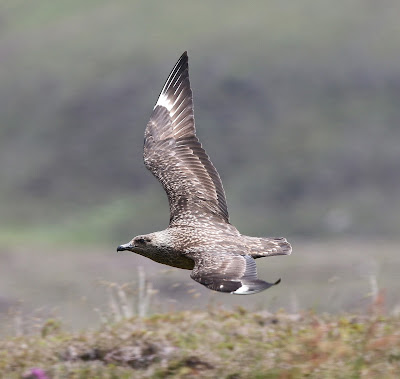It surely is an ill wind that blows no good. The winter storms
that resulted in the devastating sea surge along the east coast during December
2013 caused extensive damage to the overall ecosystem of the North Norfolk marshlands
and dune systems, the effects of which still resonate. Most of the affected
areas are only slowly recovering. And yet........
At NWT Cley Marshes for instance there is more shingle now, piles
of it; powered 100 metres inland by the uncontested might of the rampant North Sea.
This mass of eroded rock fragments has covered some grassland where skylarks
used to sing their sweet song and has smothered small pools where tiny starlet sea
anemones once dwelled. But it has also created opportunities for those birds
that love to nest on these exposed expanses and has allowed NWT reserve staff
to fence off large tracts of the newly extended habitat to create larger undisturbed
zones. To date little ringed plovers and avocets have taken advantage of these
quieter areas and the carpets of yellow horned-poppies all along the shingle
spit from Salthouse to Blakeney Point, sprouting from seeds dispersed by the
flood are to die for.
 |
Avocet Nest on Shingle Beach |
 |
Essex Skipper |
 |
Six-spot Burnet |
 |
Meadow Brown |
 |
Life is Everywhere |
But for me the most fascinating bonus from the storm damage can
be seen at Gramborough Hill, just east of the Salthouse beach road. Here the
sea has sliced a chunk off the north face of the small hillock to create a low
sandy cliff which has been chosen as a nesting site by a colony of sand
martins.
I spent a happy hour there watching the adults hawking insects
over the grass clad slopes atop the recently formed cliff and cavorting
together over the beach. Some newly fledged birds were also honing their aerial
skills, whilst younger nestlings gathered at the entrance to nesting burrows
waiting for the next mouthful of juicy fodder. I snapped away at these
incredibly fast moving hirundines trying to capture them in pursuit of flying
insects invisible to me. My hit rate was ridiculously low, but a few shots bore
fruit and showed some fascinating postures, attitudes and habits. Some images captured
birds preening mid-flight with their heads turned upside down to facilitate
easy access for their tiny sharp claws to those awkward to reach spots. Several
caught birds with throat pouches crammed full with insects showing what wealth
of prey items are available to them within 100 metres of their summer homes. Others
simply illustrated what graceful masters of the air these diminutive migrants
are. There is no way I would have been able to properly observe these nuances
without being able to freeze the action at 1/5000 of a second. Even then their
movements were so swift that only a handful of my handheld efforts were
acceptably sharp(ish). I do like a challenge. Lovely birds, sadly one we seldom
get a chance to look at closely nowadays. However these plucky ones have shown
how quickly they are able to exploit a new resource and hopefully they will be
a feature here for many years to come.
An ill wind indeed blew 18 months ago, but it has, in unforeseen
ways, blown much good.





















